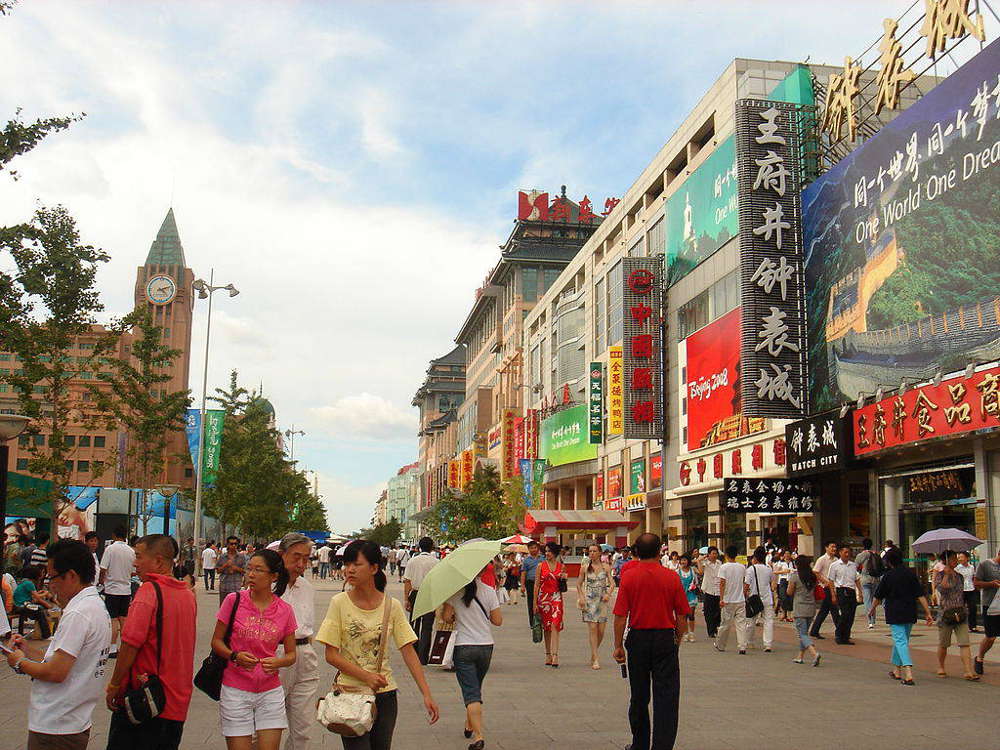[Photograph - Wangfujing street in Beijing by Nggsc under Creative Commons]
My colleague, Venkat Raman, who spent several years in China studying at Peking University, has been trying to make academic connections with China ever since he came back to India, but with limited success. Yet, on our recent visit to China there seemed to be a change of heart, with deans of several business schools happy to meet us. One even came to office specially on a Saturday, as that was the only slot we had available. What made the difference?
Psychologically at least, one number seems to have made all the difference. Almost every business school dean we met mentioned that the Indian economy would be growing faster than the Chinese economy this year. Some of them even knew the exact projected figures. Prime Minister Narendra Modi’s visit to China earlier this year figured in our visit too, with our guide at the Wild Goose Pagoda at Xi’an even showing us a picture of Modi with the Chinese President on his smartphone. But clearly, more than anything else, the Indian Growth Story talks!
Where the slowdown shows
China may be going through a relative slowdown but you wouldn’t guess it from the crowds thronging up-market stores. But, according to locals, where it really shows is in wage rates. Wages in China had been going up steadily over the years and employers told us about the grim challenge they faced in the past in keeping people costs under control, and in retaining qualified talent. But that’s changing rapidly now, and one restaurant owner told us that cooks who left earlier are now coming back to ask for a job, and at a much lower pay.
A slowdown in real estate has seen a huge increase in rents as property owners seek to maintain the return on their investments. I was shocked to hear from a business school professor friend that the monthly rental of his modest three-bedroom apartment in Shanghai is 20,000 Yuan (1Y = Rs 10 approximately).
Rents are not the only costs that are high in contemporary China. If you want to send your child to an international school, it can set you back by about the equivalent of Rs 25 lakh per student per year compared to around Rs 8 – 10 lakh per year here in India. Friends in China explained this in terms of demand and supply but there is more to this than meets the eye, and merits further investigation.
Shift in locus of construction
My last visit to China was almost a decade ago. At that time there was construction everywhere in Beijing and Shanghai, and the other cities I visited. This time, there were still signs of construction in Shanghai but clearly the boom time is over. Beijing looked stately and very much like the capital of a major world power. But Xi’an in western China was a major exception—there were cranes and barricades everywhere as the city gets major investments, and a big facelift. Peering behind the scaffoldings, I noticed that what was being replaced looked old and run-down, only confirming again what we already know that much of the early development and growth in China happened on the east coast and certain selected provinces.
While on the subject of construction, one practice from China that we could do well to adopt is very neat and aesthetic scaffolding of all buildings under construction. Not only does this enhance the appearance of building projects but it also suggests a greater sensitivity to safety concerns.
Balancing short and long-term
One thing that impressed me was the clever combination of short-term commercial returns with the long-term interests of the country. Take the case of the world famous terracotta warrior statues near Xi’an. On the one hand there is a world-class museum complex that captures in-situ the grandeur of these works of art and makes it accessible to the international and Chinese tourist; on the other, China is reportedly going slow on further excavation of the warriors as it looks for improved techniques that can help in safer excavation. We were also told that a nearby hill where an ancient king’s tomb is believed to rest will not be excavated till the government is sure that they have the right methods to retrieve and store the tomb for posterity. This keen sense of history is something we often miss in India.
Time for cleaning-up
China’s three decades of rapid growth came with its share of externalities. High pollution levels have become a feature of large Chinese cities. But China appears to be capable of applying to environmental cleaning the same pragmatic streak that enabled it to drive rapid economic growth. In his book Dealing with China, Hank Paulson writes about how he found the Chinese leadership very responsive to environmental concerns when he broached the topic with them. I got a more authoritative confirmation from a senior banker I met in Shanghai. His bank recently received a proposal for the expansion of a waste-to-energy conversion facility in one of China’s largest cities. When he sent his team to inspect the project, he expected to hear stories of large mounds of stinking waste spoiling the environment, much like the reports we read in the Indian press about the waste dumps in Indian cities. Instead his team came back and reported a clean, well-maintained facility with even the walls of the office building being free of soot and dust. In complex, messy, democratic India, we often hear that technocratic solutions don’t work; but from all reports, they can and do work in the People’s Republic of China.
Apart from pollution, the other great clean-up is in public life. Reminiscent of the Emergency period in India and some phases of Lokayukta activism we have seen in some Indian states, no day passes without reports of yet another high-ranking officer who has been stuck with corruption charges. But, unlike in India, the movement is serious with several big names having been caught and punished. Signs of conspicuous consumption have become taboo, and visible signs such as luxury car sales have apparently declined. I certainly saw few high-end luxury cars on the road.
Appearances matter. India gets a bad press because everything is out there in front of your face—whether it be poverty or stagnant cesspools. An important practice in China is keeping things away from view. The sides of highways, for example, have either walls or thick shrubs that obscure sight of what lies beyond them. And, you don’t even realize this when you are on the highway, it’s so well camouflaged.
Egalitarianism: Good for inclusiveness but not for service culture?
As we boarded a taxi from our hotel in the southwest of Shanghai to make the long trudge across a city diagonal to the northeastern university town of Songjiang where the Shanghai University of International Business Is located, we got a most pleasant surprise when the driver told us that his daughter was doing a PhD at the same university. He was delighted to take us there, and even offered to wait for us if we wanted to return; he would have lunch with his daughter in the meantime! This simple instance could be a pointer to the growth and inclusiveness of the Chinese higher education system in recent years.
The cultural revolution sought to remove all vestiges of feudalism from China. Family ties and other kinship relationships that could engender familial loyalty were deliberately weakened. While this has undoubtedly contributed to the absence of visible hierarchies and better gender equity, some service encounters made me wonder whether a lack of consumer sensitivity and responsiveness were unintended consequences of this. There was a bit of “this is what is good for you, I don’t care what you ordered” even if such a sentiment was not expressed in so many words.
Egalitarianism notwithstanding, while we have been hearing for some years now about the government’s efforts to expand English speaking skills in China, I didn’t see too much evidence of it on the ground. While the staff of large hotels and other service establishments that interact with foreigners had some English conversation ability, this was noticeably absent in any provider on the street or even security staff.
On IT and software
I had been warned that I wouldn’t be able to access our institute’s gmail-based email system while in China, so I was all prepared. But strangely while this turned out to be true in Xi’an and Beijing, I didn’t face the same problem in Shanghai. I can’t imagine that this is because Shanghai has always been China’s most “Western” city in spite of it being on the eastern side of China. Equally interesting was the fact that while in China I kept seeing pop-up advertisements for virtual private networks (VPNs) that could help one get around China’s internet controls.
While on the subject of software and IT, I was amused to learn from a friend that Chinese companies (like their Indian counterparts?) are reluctant spenders on software and IT. Though we often assume that logistics in China must be smooth and efficient, this is apparently not always the case.
Tailpiece
China is undoubtedly going through a fresh phase of change. For us in India, from an academic point of view, there will be much to study and analyse, but from the perspective of business and economics, there will be many opportunities for collaboration and growth. It’s not enough for the government of India to be more externally-oriented; this orientation has to filter down to all of us too!




Shashidhar Jayaraman on Nov 04, 2015 7:49 a.m. said
Hi,
Well written article, it would therefore be interesting to know the few things that India needs to do right to sustain growth, if they were to continue and grow higher than China in the near future.